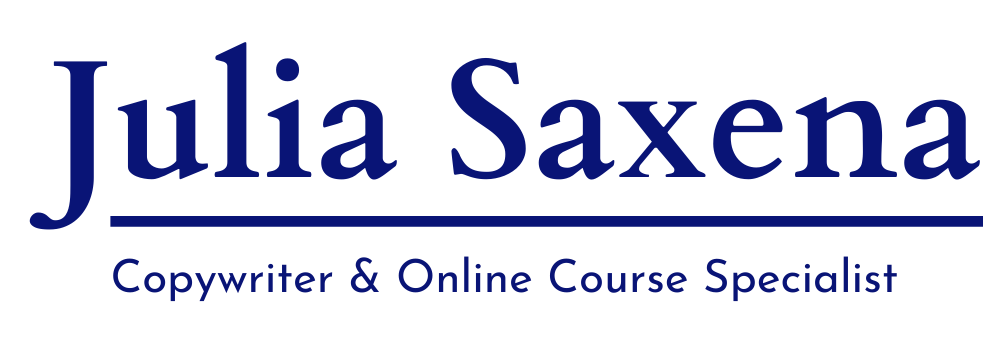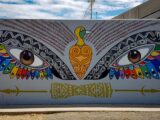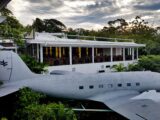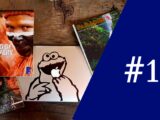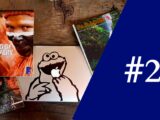I’m completing this annual review on a snowy weekend in February, here in Toronto, Canada. Getting this public version of my review published has been sitting on my to-do list for weeks—something I kept meaning to get to but hadn’t quite finished.
I actually started reflecting on 2024 back in December and continued the process into January. By then, my Notion doc had become a messy but complete record—full of my answers to reflection questions, major highlights from the year, and a preview of what’s ahead in 2025. Technically, that should have been enough.
But this year, I had an extra push to go beyond my private notes. As part of co-hosting the Annual Review 2025 Workshop with Tiago, we encouraged participants to create an artifact—something they could share with the world.
At first, I’ll admit—I dreaded the idea of turning my messy reflections into a polished, public piece. But then I remembered one of my key lessons from this year (which you’ll read about soon): How can I make this the most enjoyable?
And the answer became: ChatGPT.
Instead of struggling through endless drafts, I spoke each section aloud using ChatGPT’s voice-to-text feature—letting the tool transcribe and refine my thoughts as I went. This made the entire process faster, smoother, and, most importantly, way more fun.
So without further ado, let’s dive into my 2024.
Work Highlights
2024 was my third year at Forte Labs, and if I had to pick a theme for the year, it would be growing our evergreen and recurring revenue. In 2023, we focused on diversifying how we made money—trying out different offers and revenue streams. But this year, it was all about doubling down on what works and making it more sustainable.
Since we officially retired the cohort model, we needed a way to keep our self-paced courses thriving without constant hands-on effort. That meant refining our automated funnels to bring in steady revenue while also building up recurring revenue streams—a key piece to making our business more predictable.
The biggest career milestone for me in 2024 year was stepping into the role of General Manager in October! I took on full responsibility for Forte Labs, expanding my role beyond just marketing and product to also include the behind-the-scenes mechanics—operations, finances, and overall business strategy.
Email personalization & segmentation
2024 kicked off with a four-month deep dive into email personalization, working alongside Brennan Dunn and his team at Slice & Dice. The goal was to segment our audience so we could send them more relevant, personalized emails—ultimately leading to higher conversions and more revenue.
Before this project, things were…a bit one-size-fits-all. I had set up one automated email funnel that connected all 14 of our different lead magnets and opt-in offers to a single pitch for our self-paced course, Building a Second Brain Foundation. It worked, but we knew we could do better.
Fast forward four months, and we had a much smarter system in place. Now, no matter where someone joins our email list, they’re immediately greeted with a segmentation survey powered by Brennan’s tool, RightMessage.
This quick survey helps us understand their goals, challenges, and experience level, and based on their responses, they’re guided into one of three personalized funnels leading to:
- Building a Second Brain Foundation (for those just getting started with knowledge management)
- Pillars of Productivity (for those looking to boost their focus and workflow)
- The Second Brain Membership (for those who want ongoing support and community)
The results: a 62% increase in sales from new leads. 🎉
If you’re curious about the details, check out the case study and my blog post on how we segmented our subscribers.
Launching the Second Brain Membership
What started as a private community for Building a Second Brain cohort students officially became a public membership in 2024. And this year, I took full ownership of it—running it independently alongside our fantastic facilitator, Maria.
It’s been so fun watching the Second Brain Membership grow. In September, we were bringing in $10k in monthly recurring revenue (MRR). By February 2025, we’re hosting 550 paying members and doubled our MRR to $22k.
I see 2025 as a year of transformation for the membership. I’m especially excited to introduce monthly themes—essentially turning the membership into a guided, year-long curriculum that helps members systematically build their Second Brain. And beyond that, we’re expanding the scope: not just helping individuals build their own knowledge systems, but also equipping them to extend these practices to their teams and organizations—creating shared knowledge environments where everyone thrives.
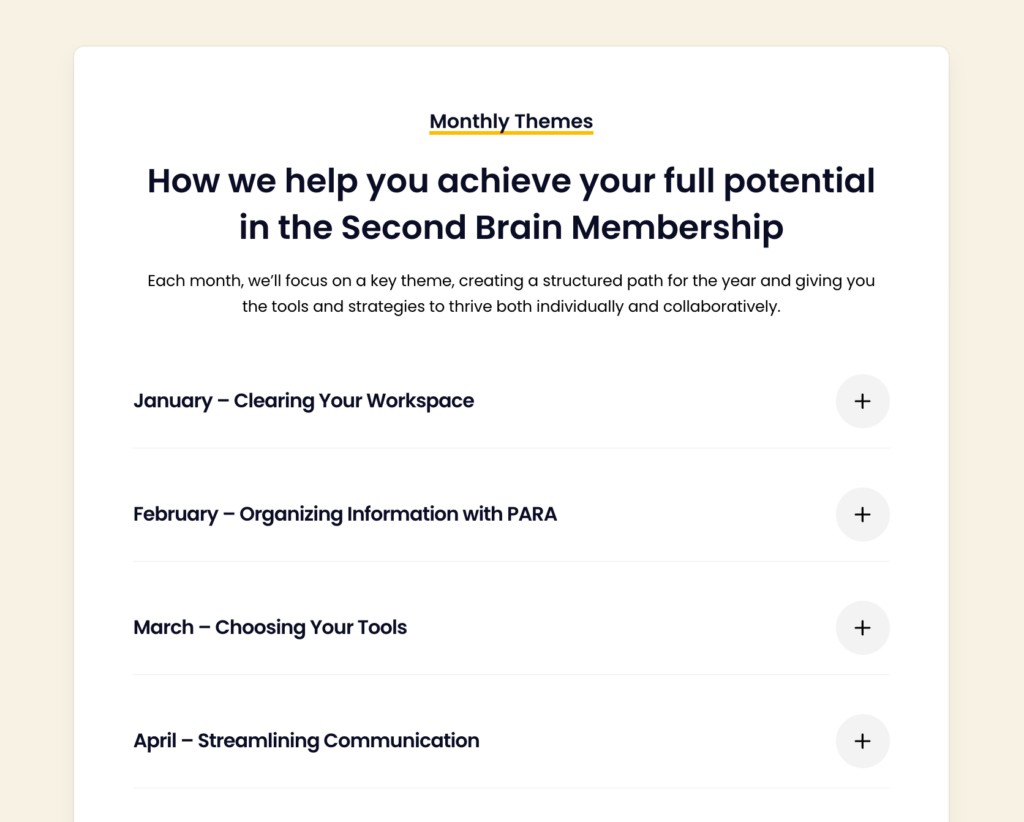
A personal highlight for me has been leading our weekly office hours and hosting guest workshops. I enjoy growing and evolving the membership and learning more about community engagement. Taking this on has been a personal challenge and one that I’m incredibly excited to keep pushing forward.
Hosting the first in-person Second Brain Summit
One of the absolute highlights of the year—and easily the biggest project—was hosting the first-ever in-person Second Brain Summit. After I ran virtual summits in 2022 and 2023, we made the leap to a large-scale, in-person conference, bringing together over 200 attendees in Downtown LA on October 3rd–4th.

Planning a conference of this scale was no small feat, and we were lucky to work with the incredible team at Simply Storied, who guided us through months of preparation. I learned so much about running in-person events—from the logistics to the energy needed to keep things running smoothly—and it was an experience I’ll never forget.
On a personal level, I loved working on the marketing and sales strategy and shaping the attendee experience from their very first interaction all the way through the event (and beyond). Seeing it all come together was surreal, and getting to meet our community in person was by far the best part. I even had the opportunity to moderate a panel on Notion, which was another highlight!
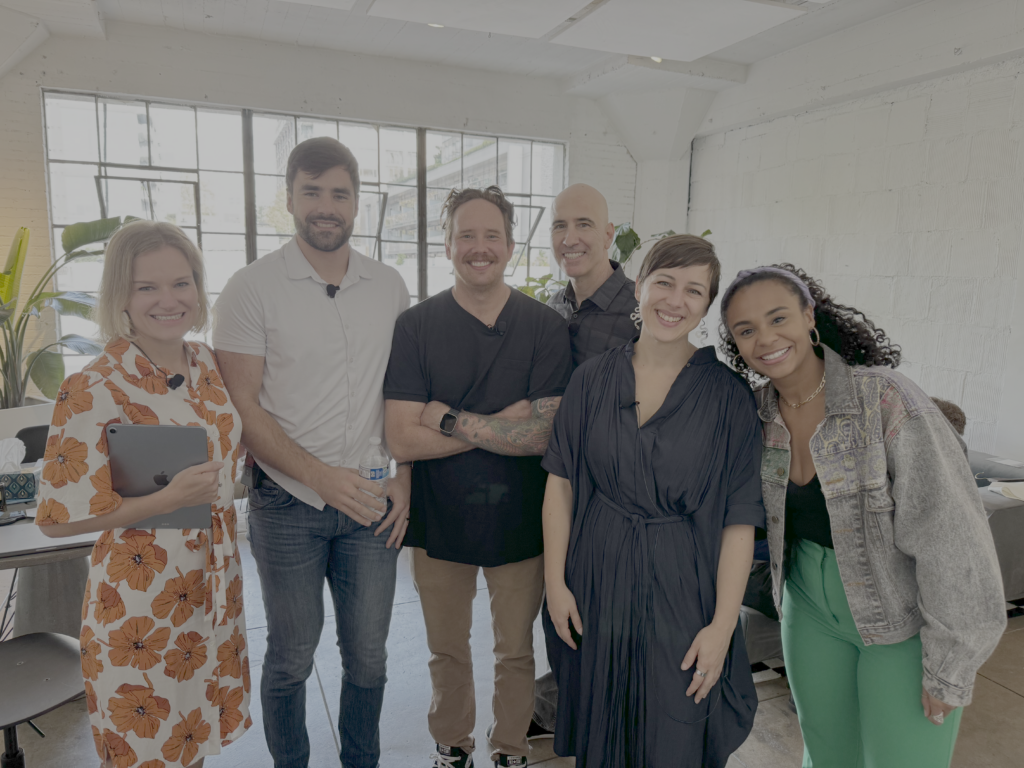
That said, not everything went according to plan. Financially, the event turned out to be more challenging than expected, and it didn’t bring in the results we had hoped for. We took an honest look at what worked, what didn’t, and what we’d do differently next time, which you can read more about in our in-depth reflection blog post.
Despite the financial hurdles, I wouldn’t trade the experience for anything. Seeing our community come together in real life—learning, sharing, and connecting—was something truly special.
We also took this opportunity to get together as a team in Long Beach and spend two days reflecting on this big milestone and planning the next months.
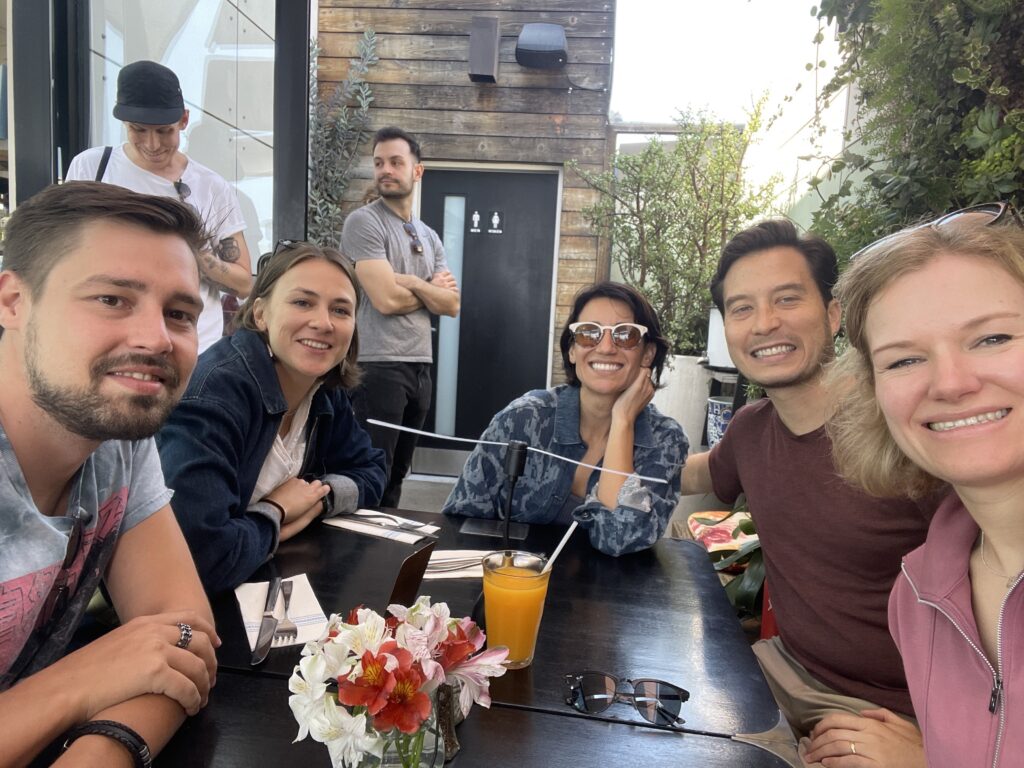
Running the Annual Review 2025 Program
With Tiago’s next book focused on the powerful ritual of Annual Reviews, the end of 2024 was the perfect opportunity to put his research to the test. He wanted to take everything he had refined over the past decade and run a final cohort through his process—seeing how it resonated in practice with our students.
So, on Black Friday, we launched our most in-depth Annual Review program ever, a six-week guided experience that ran from December to January, bringing together 150 students from all over the world.
One moment that really stood out to me was right before the first live session. Tiago and I met just 10 minutes before we were set to go live, and we both had this moment of reflection. Back in the days of our Building a Second Brain live cohorts, these sessions required multiple team members, a long Zoom checklist, and a hefty amount of prep. But this time it was just the two of us, running everything smoothly, and—somehow—it didn’t feel like an overwhelming heavy lift. It was a clear reminder of how far we’ve come in streamlining our processes while still delivering high-impact experiences.
As soon as the live cohort wrapped up, I turned it into a self-paced version—so now anyone can go through the Annual Review process at their own pace. If you’re curious, you can check it out here.
Personal Highlights
Challenging my body in new ways
A fun personal challenge I took on was the WWF CN Tower Climb, where I tackled all 1,776 steps of Toronto’s tallest landmark. Out of 2,448 participants, I finished 177th overall—and was the 21st fastest woman! It was an intense but incredibly rewarding experience, and I’m really proud of that achievement.
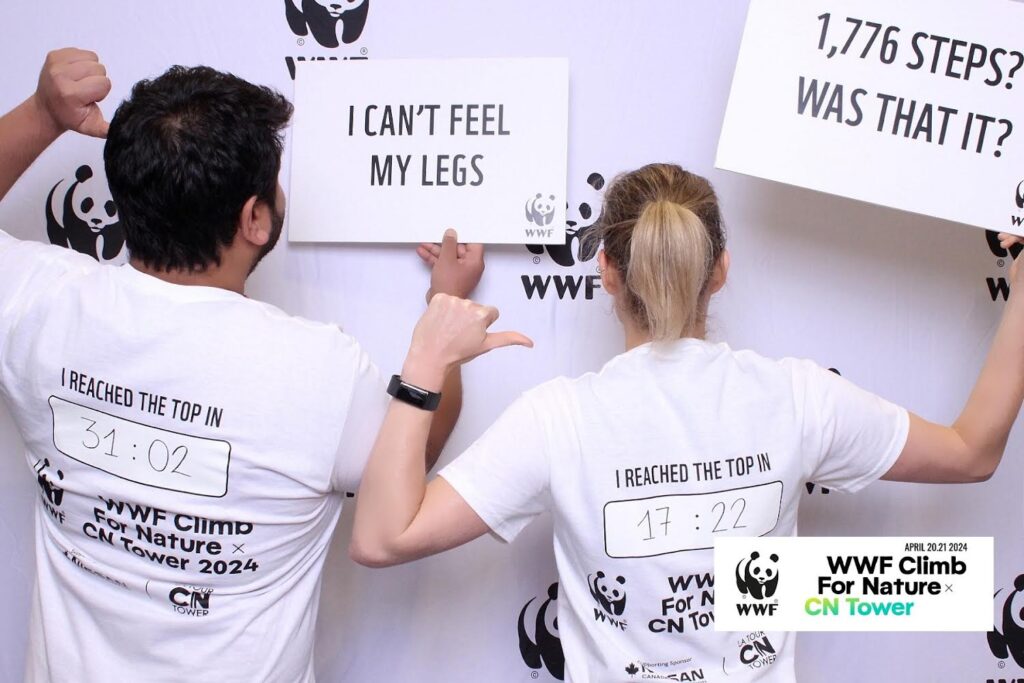
Later in the year, I hit another milestone in Krav Maga, earning my Red Belt and stepping into instructor training for the first time. In 2025, I’ve got my sights set on an even bigger goal—earning my Black Belt.

Going deep in the Connection Course & Master Class
I’ve known about Art of Accomplishment for years—their podcast has been one of my absolute favorites, and I highly, highly recommend it. But in 2024, I finally felt called to take the next step. I jumped into their courses, starting with the Connection Course in March (so good that I repeated it in December!) and then diving into the Master Class in June and July.
And I can confidently say: these courses are unlike anything else I’ve experienced. And I’ve taken a LOT of online courses over the years—from self-paced to cohort-based.
Most online courses follow a predictable structure: some reading or video material, followed by Zoom calls where half the people have their cameras off, and only a handful actively participate. The AoA approach is completely different. There’s no passive learning. You’re not just listening—you’re doing the work.
They understand that the real bottleneck isn’t intellectual comprehension, it’s application and practice. It’s about experiencing and recognizing the feeling in your body when you do something differently than you normally would. That’s why every live session is a series of interactive experiments—done with a partner or in a group—focused on real-life situations, not hypotheticals.
It can get intense! I’ve cried on multiple occasions but always felt lighter, almost euphoric afterward. Surprisingly, opening up about things I’d normally only discuss with a close friend or therapist to someone I just met in the course felt easy. That’s because the AoA team does an incredible job of creating a safe space with strong community agreements and clear boundaries.
You just know that everyone is fully present and invested in this journey as much as you are. And suddenly, digging deeper and talking about the big stuff doesn’t feel so scary anymore.
The results have been a deeper self-understanding, revealing patterns and beliefs that weren’t serving me. I’ve also learned to recognize these patterns in others, which has created a profound sense of compassion for why people behave the way they do. It has given me a new level of confidence and resilience, knowing that no matter what happens, I can connect with others and fully enjoy life.
Travel to connect with friends & family
One of the ongoing challenges of my life is living far away from my closest friends and family—most of whom are in Europe. No matter how much we stay in touch online, nothing truly replaces seeing each other in person.
So in 2024, I made it a priority to close the distance—taking trips to Amsterdam, Germany, the U.S., and across Canada to spend time with my friends, parents, and in-laws. And honestly, each trip was a highlight of the year.
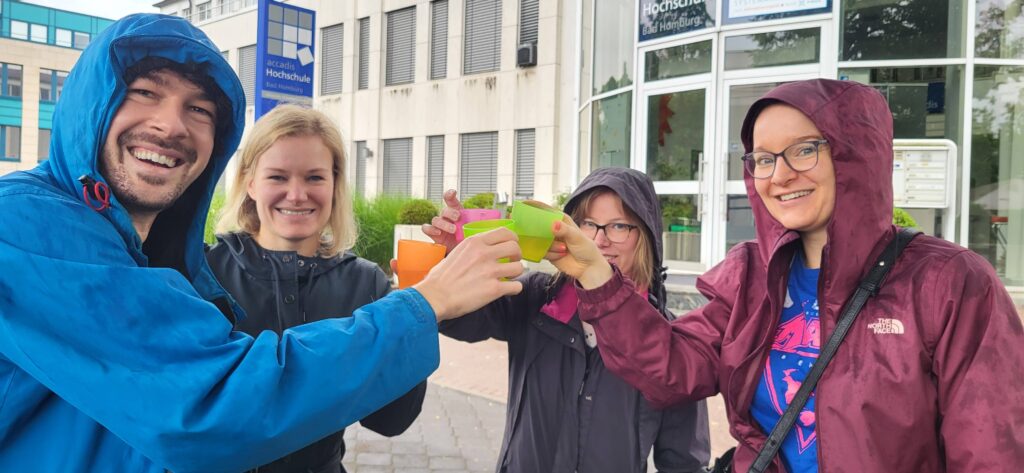

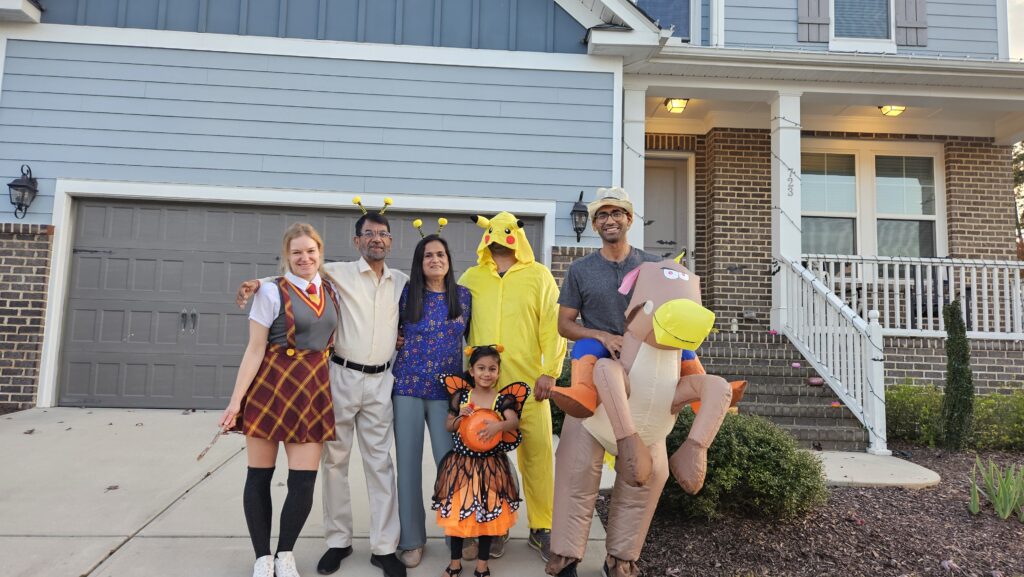
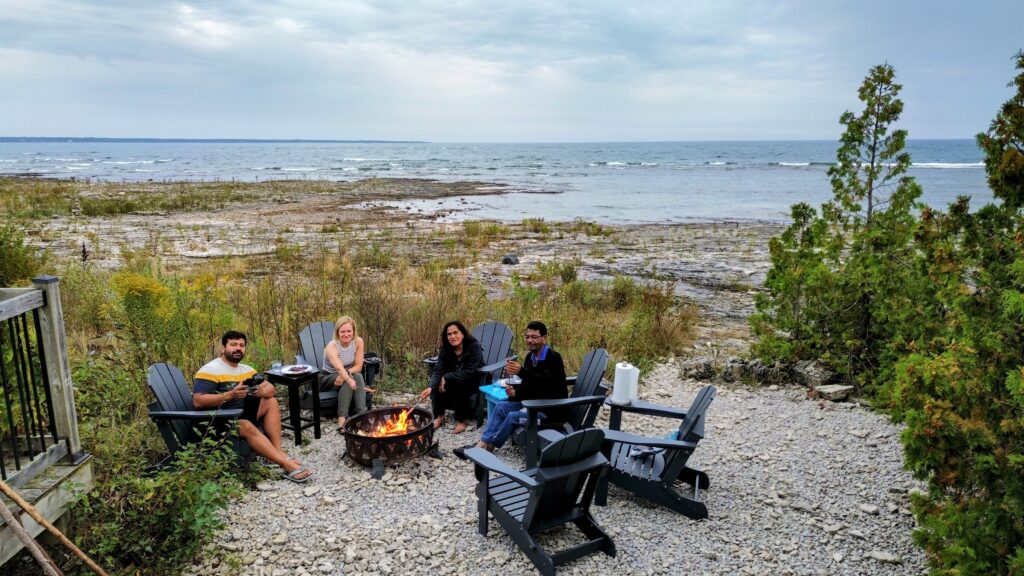
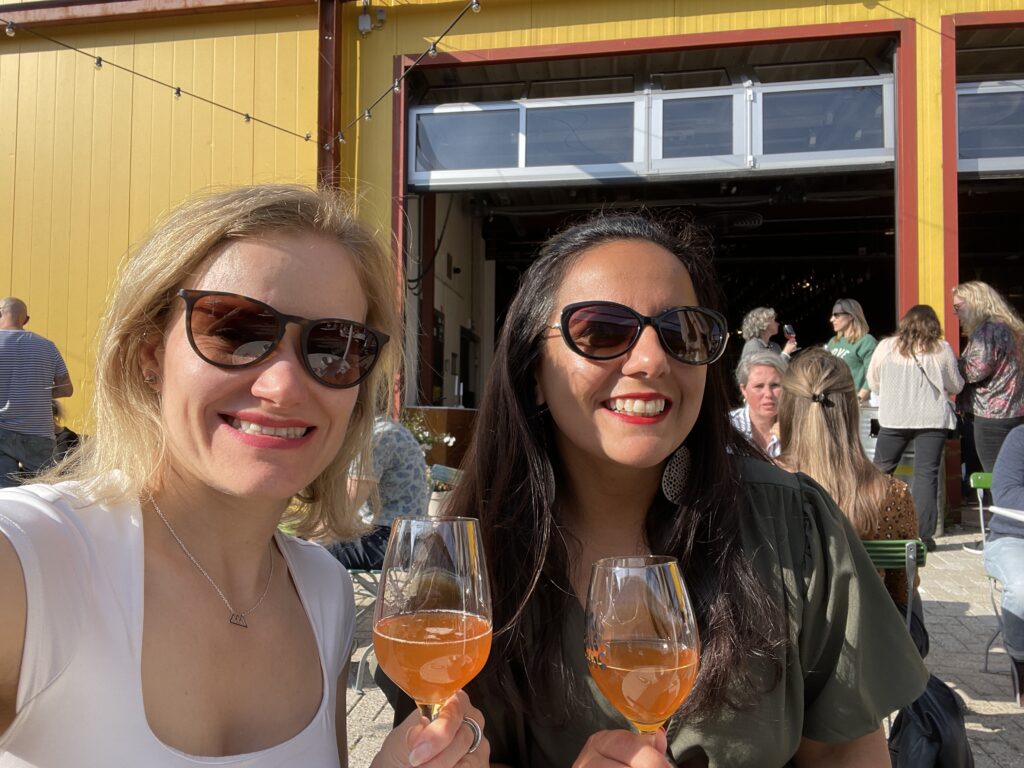

There’s something so special about reconnecting in person. It reminded me how important it is to make the time and effort to nurture these relationships, no matter how far apart we are.
I’m definitely carrying this intention into 2025—continuing to make space for travel, connection, and quality time with the people I love.
Redesigned Course Creator Lab
In my last annual review, I lamented that CourseCreatorLab.co was still just a janky Notion site. Well, I’m happy to report that in 2024, I finally gave it the upgrade it deserved—moving it to a proper website on Squarespace!
I had a lot of fun designing it myself and tinkering with layouts, colors, and copy.
But… there’s a catch. After that initial burst of enthusiasm to get the new site live, my momentum totally stalled—and I didn’t published anything in the second half of the year. Making time for writing just for myself has been a real challenge, so while I’m calling this a win, it’s more like a half-win.
Discovering coffee
I feel a little silly writing this—especially when so many people are proclaiming they’re quitting coffee and cutting out caffeine—but in 2024, I finally joined the coffee-drinking club.
It all started with a trip to Colombia in February, where I visited a coffee farm and got a firsthand look at the entire coffee-making process—from bean to brew. Learning about the craftsmanship and care that goes into each cup gave me a newfound appreciation for coffee.
Here’s a short video I made about the whole trip:
Since then, making coffee with my AeroPress has become a small daily ritual. But because I never really drank coffee before, I’m still super sensitive to caffeine, which means I’ve had to set a few personal coffee rules:
- One cup per day—max.
- Nothing after 2 pm (unless I want to stare at the ceiling all night)
- Occasional caffeine breaks to keep it in check
And I have to say—I’m really enjoying it! So much so that one of my goals for 2025 is to upgrade to a proper coffee machine and even take a barista course to level up my skills. Who knows, maybe I’ll master the art of latte art by next year!
Lowlights & Challenges
Audience Growth & YouTube
2024 was one of the most challenging years for us in terms of audience growth. We saw declining web traffic to our blog—which had historically been a major driver of new email subscribers. As a result, we added only 22,000 new subscribers to our email list this year—39% fewer than in 2023. This also meant that our freshly redesigned funnel is being fed fewer and fewer new leads.
But we’re not alone in this. After speaking with many other creators, we realized this is a wider trend—some are even experiencing a decline in their email lists altogether.
Our YouTube growth also hit a rough patch. We gained only 6,000 new subscribers in 2024—bringing us to 288,000 total—which was 36% less growth than in 2023. The main reason was a series of videos that didn’t resonate with our audience, which killed our momentum.
Midway through the year, we pivoted to a different video structure, and by the end of 2024, we started to see some great wins. Unfortunately, they weren’t quite enough to fully recover the lost momentum.
On the bright side, we have an incredibly solid YouTube team—they love what they do and are fully committed to the success of the channel. So while this year was a tough one, we’re in it for the long game—learning, adapting, and setting ourselves up for stronger growth in 2025.

B2B
In April, I had the privilege of attending a business development training in Atlanta by the Bunnell Idea Group. One quote from Mo Bunnell’s new book really stuck with me:
“I wake up every morning looking to help my friends succeed, and some just happen to be clients.”
According to Mo, the biggest predictor of success in B2B isn’t just having a great offer—it’s relationships. And that was the central focus of the training. I left energized and motivated to make B2B work for us.
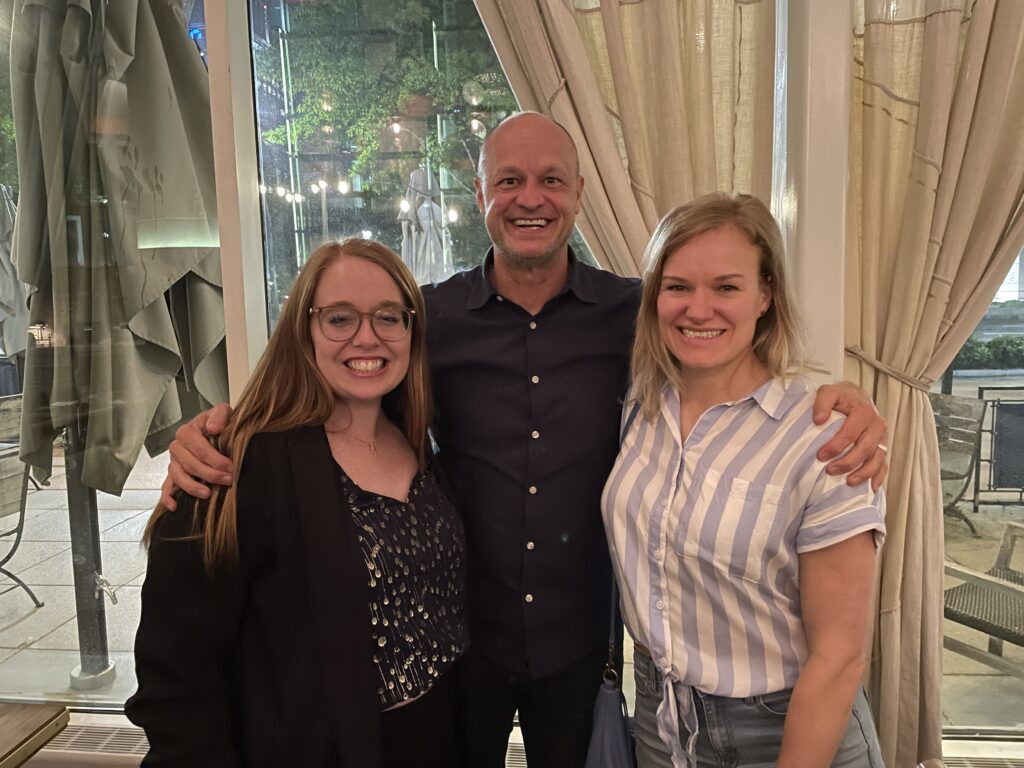
But I quickly realized that selling B2B is a completely different game. Unlike the hands-off, online-first B2C approach we’re used to, B2B requires a different mindset, longer sales cycles, and high-touch relationship-building.
We also found ourselves stuck in another dilemma: we were working to close B2B deals, but at the same time, we weren’t fully equipped internally to deliver those trainings at scale. Ultimately, this meant we didn’t follow through on B2B as much as we had hoped.
That said, I now see a new path forward. The Second Brain Membership could be our way into the B2B space—especially as we reposition it with a stronger focus on helping teams and organizations create shared knowledge environments. Instead of trying to build a separate B2B offering from scratch, we may already have the perfect entry point—we just need to lean into it.
My personal newsletter and online presence
In 2024, I sent 16 personal newsletters—which, considering they’re supposed to be weekly, is… not exactly a win. And after rereading my previous annual review, I realized something frustrating: this exact pain point hasn’t changed at all.
Beyond my newsletter, my online presence in general took a backseat. I only posted on LinkedIn and other platforms a handful of times, despite telling myself that building my personal brand and sharing my thoughts more publicly is important to me. The reality is that I didn’t take the steps in 2024 to make that a priority.
Lately, I’ve been asking myself why this continues to be such a challenge. What is it about showing up online that feels so difficult? Why does it remain a sticky point for me, year after year?
I don’t have the answers yet, and I’m not entirely sure how I’ll approach it differently in 2025. But it’s something I’m actively reflecting on, and I know that understanding why this is a challenge is the first step toward finally changing it.
6 Lessons Learned in 2024
For years, I invested a lot of time and money in growing my hard skills—taking courses on copywriting, marketing, project management, and more. But in 2024, I felt a significant shift. Instead of focusing on professional skills, I turned my attention inward—to personal growth.
Many of the biggest lessons I learned this year were deeply influenced by my experiences in the Art of Accomplishment courses. These courses opened up entirely new ways of thinking and being, and I want to share six key takeaways that have had the biggest impact on me.
1. Listen to My Whole Body
This year, I really learned to welcome all of my emotions—to stop resisting them and instead let them move through me naturally. My experience in the Nervous System Mastery course was a turning point in understanding that emotions aren’t something to fight or suppress; they’re simply a natural part of us.
I realized that the real pain isn’t the emotion itself—it’s the resistance to it. Even emotions we often label as “negative”—like sadness, heartbreak, and grief—can be beautiful and profound when we stop trying to push them away.
A powerful tool that helped me with this was Focusing, a technique introduced in the book by Eugene Gendlin. It helped me recognize that those subtle, uneasy feelings we sometimes get—where we ask ourselves, “Why does this situation feel off?”—are actually our body’s way of communicating with us. Instead of ignoring those sensations, I’ve learned to tune in and listen.
2. Find Enjoyment in Everything
One of my favorite questions from Joe Hudson is: How can you enjoy this 10% more?
This question completely shifted the way I approach my daily life. It reminded me that enjoyment isn’t something that just happens to us—it’s something we can create.
Now, I ask myself questions like:
- What’s the most enjoyable path here?
- What would it look like if this was easy?
- How might I be overcomplicating this?
That doesn’t mean I only do things I find enjoyable—it means I actively find enjoyment in tasks that aren’t naturally fun.
Take email, for example. I’ve never particularly enjoyed dealing with my inbox, but I made it a personal challenge to figure out how I could make it more enjoyable. It’s a small mindset shift, but one that makes a huge difference.
3. Be in the Question
One phrase that comes up often in the Art of Accomplishment courses is: Stay in the question.
At first, this was frustrating—after all, when we ask a question, we expect an answer. That’s how we’ve been trained to think. But what I’ve come to understand is that there’s tremendous value in simply staying in the question itself—remaining in a state of wonder, openness, and curiosity, instead of rushing to find the “right” answer.
We’re so conditioned to seek certainty, to immediately grasp for solutions—but what happens if we don’t? What if we just sit with the question and let the answer emerge organically over time?
4. Stop Listening to “Shoulds”
Telling yourself you should do something is just a mechanism for shame. It’s a terrible self-management technique, and yet, all of us rely on it.
I’ve noticed that every time I tell myself I should do something, it creates this internal rebellion—a resistance that pushes back against the very thing I’m trying to do. And that’s probably why so many of the things we’ve been telling ourselves we should do for years still haven’t happened.
For me, this has shown up in areas like my online presence. I’ve been telling myself: I should be posting on LinkedIn. I should be writing my newsletter every week. But it’s not working.
So instead of focusing on shoulds, I’ve shifted to wants. A want is a natural impulse from within—something that pulls me toward it, rather than something I feel like I have to force myself to do. It feels expansive instead of restrictive. And that shift has been huge for me.
5. Let Them
I’ve labeled this lesson “Let Them” after a fantastic Mel Robbins podcast a friend recommended to me. The core idea is to stop trying to manage other people and focus on yourself instead.
The truth is, we can’t change other people—and trying to is usually just a waste of energy. Instead of spending time and frustration wishing others would act differently, I’ve learned to simply let them: Let them do what they want to do. Let them make their own mistakes. Let them be on their own journey.
But this doesn’t mean I’m powerless—far from it. While I can’t change another person, I can change the dynamic between us. I can choose how I respond, how I behave, and what boundaries I set. Shifting my focus to what I can control instead of what I can’t has been incredibly freeing.
6. Drop the Defense
In arguments, I’ve started asking myself:
- What am I actually defending?
- What am I holding onto?
- Where is my ego getting in the way?
- Am I trying to win or be right?
I’ve always had a bit of a perfectionist streak, constantly trying to do things the “right” way. But I’ve come to realize: people don’t want perfection—they want connection.
So I’ve been shifting my focus toward connection over being right. That means being more vulnerable, owning my mistakes, and saying sorry—not as an obligation, but as a way to genuinely acknowledge when I’m wrong.
Looking ahead at 2025
One of my favorite exercises from our Annual Review 2025 Program was the Excitement Map. It’s a simple but powerful process: instead of focusing on what I should do or what I need to accomplish, I mapped out everything that genuinely excites me—things that give me a visceral, physical sense of energy.
This exercise was so much fun, and I want to share my excitement map here. It’s a big-picture overview of things I might explore, dive deeper into, or turn into actual projects throughout the year. Some of them have already taken shape, while others are still waiting for their moment.

A crucial lesson I’ve learned is that setting a goal isn’t enough—you need an actual project to bring it to life. If a goal is the destination, then a project is the vehicle that gets you there. And that’s something I’m keeping in mind as I move through the year.
Right now, I’m feeling energized and excited for what’s ahead. January has already been a whirlwind of activity. If this is how the year is starting, I can’t wait to see what’s in store for the rest of 2025.
